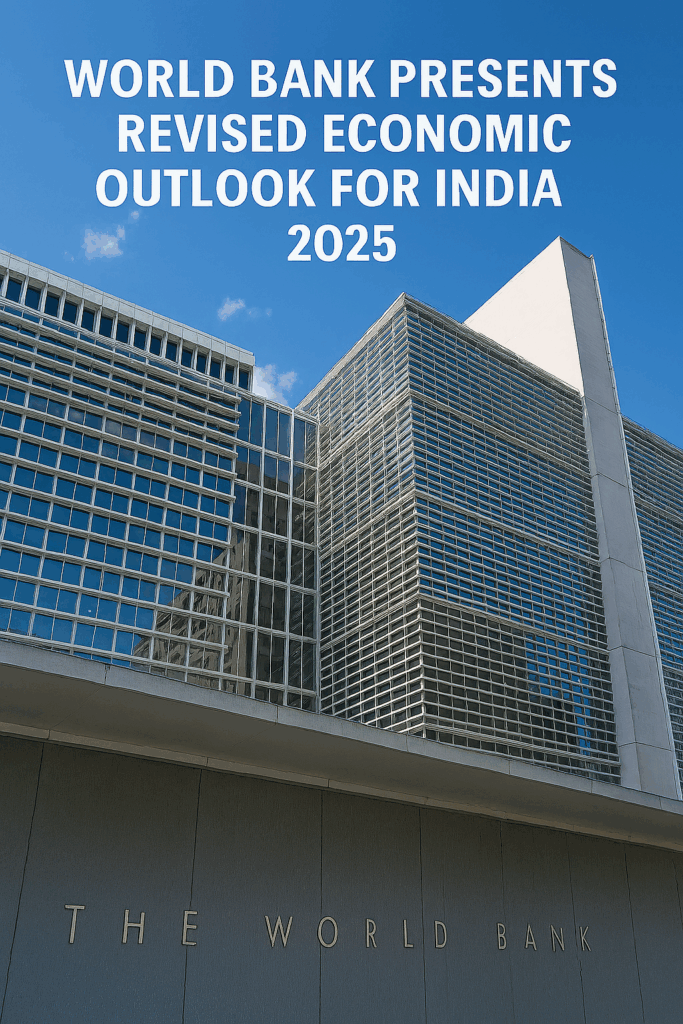
Context: The World Bank’s latest South Asia Development Update has adjusted its economic growth projection for India. It has raised the forecast for Fiscal Year 2026 to 6.5% (from 6.3%) but lowered the expectation for FY27 to 6.3%, citing the impact of new U.S. import duties on Indian goods.
Salient Points from the Update
- FY26 Projection: Growth estimate upgraded to 6.5%, driven by robust internal demand and simplifications in the Goods and Services Tax (GST).
- FY27 Projection: Growth estimate downgraded to 6.3%, primarily due to the imposition of 50% U.S. tariffs on a significant portion (nearly three-fourths) of India’s exports.
- Regional Context: The South Asia region is expected to grow at 6.6% in 2025, with India’s economy constituting approximately 70% of the region’s total output.
Factors Behind the Improved FY26 Forecast
- Public Capital Expenditure: Sustained government investment in infrastructure via initiatives like PM Gati Shakti and the National Infrastructure Pipeline (NIP).
- Strong Domestic Consumption: Supported by rising rural incomes and favourable agricultural production.
- GST Reforms: The simplification of compliance procedures and the rationalization of tax slabs planned for 2025.
- Supportive Monetary Policy: The Reserve Bank of India’s (RBI) accommodative policy stance, which enhances liquidity and encourages private investment.
- Explanation: An accommodative monetary policy prioritizes economic growth by reducing interest rates, signaling a clear intent to stimulate the economy, unlike a neutral stance that balances growth and inflation objectives.
Potential Challenges for the Indian Economy
- U.S. Tariff Measures: The 50% duty affects key export sectors like textiles and pharmaceuticals, with an estimated exposure of around 2% of India’s GDP.
- Global Economic Deceleration: The World Bank anticipates South Asia’s growth will slow from 6.6% in 2025 to 5.8% in 2026, due to spillover effects from a worldwide slowdown and international trade challenges.
- Tepid Urban Consumption: Indicators such as a decline in automobile sales (e.g., a 7.4% year-on-year drop in wholesales in June 2025) and slower growth in personal credit point towards weakening urban demand.
- AI-Induced Disruption: An estimated 23% of jobs, particularly mid-skill service roles, are considered susceptible to automation and changes from Artificial Intelligence.
Recommended Strategic Directions
- Export Market Diversification: Mitigate over-reliance on the U.S. market by deepening trade ties with the ASEAN region, Africa, and Gulf Cooperation Council (GCC) countries. The India-UAE Comprehensive Economic Partnership Agreement (CEPA) is a step in this direction.
- Strengthen Domestic Manufacturing: Enhance the effectiveness of Make in India 2.0 and Production Linked Incentive (PLI) schemes, while simultaneously improving logistics efficiency.
- Foster AI Adoption: Encourage a synergistic relationship between AI and human labour in high-skill industries through initiatives like the National AI Mission and upskilling programs on the Skill India Digital Platform.
- Sustain Infrastructure Investment: Maintain the momentum on public capital expenditure to generate employment and stimulate demand. Utilize mechanisms like PM Gati Shakti and NaBFID infrastructure bonds to secure financing.
- Boost Rural Economy: Support agricultural demand through Minimum Support Price (MSP) reforms, expanded irrigation projects, and the rollout of digital agriculture platforms such as the Digital Public Infrastructure for Agriculture (DPIA).
